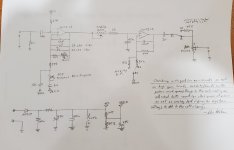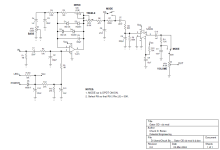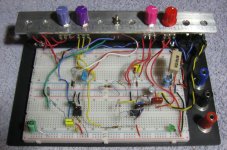Chuck D. Bones
Circuit Wizard
We held a design contest over in The Breakroom earlier this year. There were a lot of great entries and Gator's OD was one of 'em. It's based on a Timmy, with a toggle switch that allows one to drive the 2nd stage to clipping. which gives it a whole new flavor. This is the design Gator submitted. It works great as-is. Other opamps sound good too.

I couldn't leave well enough alone so I tried using an NJM386 for the 2nd stage. Unfettered by the rules of the Design Contest, I moved the BASS trimmer to the front panel. At the moment, I have an LF351 in place of the TL071. They sound the same. The MODE switch does a few things. In the "NORMAL" position, the 386 does not saturate and this circuit behaves like a Timmy, except the 386 makes it capable of driving a mile of cable. With MODE in the "SWAMP" position, the 386 is driven hard enough to saturate, the low frequencies are rolled off a bit going into the 386 and there is some high-freq roll-off after the 386. R9 has to be selected to accommodate the variation in input impedance of different LM386's. The spec sheet says the input impedance is nominally 50K, but the one in my breadboard has 95K input impedance.

Knobs, L to R: VOLUME - TREBLE - BASS - DRIVE

Try it (either way), you'll like it!

I couldn't leave well enough alone so I tried using an NJM386 for the 2nd stage. Unfettered by the rules of the Design Contest, I moved the BASS trimmer to the front panel. At the moment, I have an LF351 in place of the TL071. They sound the same. The MODE switch does a few things. In the "NORMAL" position, the 386 does not saturate and this circuit behaves like a Timmy, except the 386 makes it capable of driving a mile of cable. With MODE in the "SWAMP" position, the 386 is driven hard enough to saturate, the low frequencies are rolled off a bit going into the 386 and there is some high-freq roll-off after the 386. R9 has to be selected to accommodate the variation in input impedance of different LM386's. The spec sheet says the input impedance is nominally 50K, but the one in my breadboard has 95K input impedance.

Knobs, L to R: VOLUME - TREBLE - BASS - DRIVE

Try it (either way), you'll like it!







